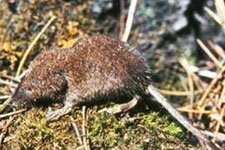Local Wildlife
Vagrant Shrew

Scientific Name: Sorex vagrans
Photo Source: Dr. Lloyd Glenn Ingles, California Academy of Sciences
Addt'l Info: Univ. of Michigan
The vagrant shrew is small mammal with reddish-brown (dark brown in winter) fur on its back and sides and a grayish-brown underside. It has an elongated head ending with a rather pointed nose, small hairless feet, and a long rat-like tail. Like several of its close cousins, vagrant shrews emit high-frequency vocalizations that they use to orient themslves. Unlike others of its species, its saliva is not toxic.
Primarily nocturnal, the vagrant shrew is most active at night. It eats spiders, earthworms, snails, slugs, salamanders, some plant material (such as fungi and roots), and various insects and other small mammals. Vagrant shrews do not hibernate and, as a result, are active year round. They are also solitary creatures, remaining alone except during mating season.
Whether in open or wooded areas, vagrant shrews prefer moist habitats and are commonly found near streams, rivers, and lakes where various grasses, willows, and other low cover provide protection from predators. Because of their size, habitat, and nocturnal nature, you are unlikely to see one of these small animals during your visit to Sunriver. However, if you take a bike ride along the river at dusk, and if you are very lucky, you might just catch a glimpse of one scampering across the bike path and into the grasses that grow between the path and the river.
Vagrant shrews mate in the spring and, after 20 days, the female produces a litter of two to nine young. One to two litters are produced per year (the second, when present, occuring in late summer). Nests are made of dry grass, moss, and other plant material and are often found in stumps or under logs, roots, or dense vegetation.
